Can someone allude to why there are steel wires in my Harman Kardon Amp? I am wanting to re-route some wire and have discovered, somewhat to my consternation, that several of the wires leading to the speaker terminals and from the mainboard its self, are made of STEEL, not copper.
1. What is with STEEL WIRES being used in my HK6100?
2. I want to replace the steel wires with copper of higher quality and thicker gauge - will I notice any difference by 'upgrading the wires' to a size that suites my re-routing attempts to move the speaker terminal wires further away from the transformer?
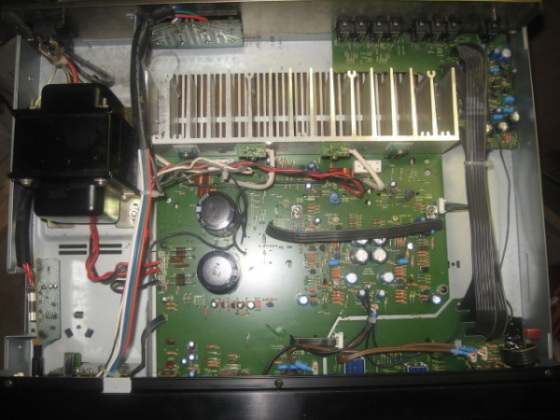
The wires running from the speaker selector switch bottom right pass a inch away from the transformer to the speaker terminals top-mid right. I want to re-route the wires around the heat sink to bypass the transformer completely.
1. What is with STEEL WIRES being used in my HK6100?
2. I want to replace the steel wires with copper of higher quality and thicker gauge - will I notice any difference by 'upgrading the wires' to a size that suites my re-routing attempts to move the speaker terminal wires further away from the transformer?
The wires running from the speaker selector switch bottom right pass a inch away from the transformer to the speaker terminals top-mid right. I want to re-route the wires around the heat sink to bypass the transformer completely.
Last edited:
1. What is with STEEL WIRES being used in my HK6100?
2. I want to replace the steel wires with copper of higher quality and thicker gauge - will I notice any difference by 'upgrading the wires' to a size that suites my re-routing attempts to move the speaker terminal wires further away from the transformer?
Are they magnetic? That is considered ok by much of the audio "establishment".
Replacing them with standard copper wires certainly can't be any worse.
Be sure to strain relief the connections.
Last edited:
Why is transformer changed?
I don't know. It's not mine. Mine is original. I got the photo from another thread: Harmon Kardon HK6100
Obvious question; how did you determine that the wires were steel?
They look like they are and they are also really 'stiff'. Photo of my HK6100
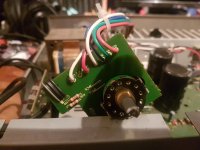
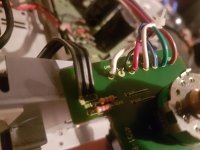
The wires from the 'speaker selector switch running to the 'speaker distribution board are as stiff as [insert expletive]. My guess is that they are 4x single core solid steel judging by stiffness and colour of the wire. The wire is NOT copper (not even tarnished copper) but are steel or aluminium colour and my guess is they are not aluminium.
The reason I am 'willing to rewire' my HK6100 is that one of the the speaker 'knobs' is broken and I've opened it up in order to do a 'Ghetto Fix' on it. For that I have to 'remove the speaker' distribution board and will effectively have 'unwire' the speaker distribution board anyway, so wiring in some heavy gauge stranded copper wire (which I already have) and re-routing the wire away from the transformer, will be a non-issue and I may as well do it anyway.
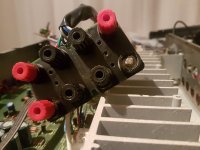
Last edited:
Well, I've also encountered copper wires that are stiff because they either have very few strands, or the PVC sleeving has aged (lost the plasticiser) and become stiff. Good quality stranded copper wire used for soldered assembly is usually tinned anyway, so it doesn't appear pink like copper either - it looks like bright tinplate as you'd expect.
Soldering steel wire connections by hand assembly would also be a dicey procedure - I can't see why anyone would do it on a 30+30W budget amp anyway.
How about using a magnet to test for ferric properties? That sure beats guessing.
Soldering steel wire connections by hand assembly would also be a dicey procedure - I can't see why anyone would do it on a 30+30W budget amp anyway.
How about using a magnet to test for ferric properties? That sure beats guessing.
Well, I've also encountered copper wires that are stiff because they either have very few strands, or the PVC sleeving has aged (lost the plasticiser) and become stiff. Good quality stranded copper wire used for soldered assembly is usually tinned anyway, so it doesn't appear pink like copper either - it looks like bright tinplate as you'd expect.
Soldering steel wire connections by hand assembly would also be a dicey procedure - I can't see why anyone would do it on a 30+30W budget amp anyway.
How about using a magnet to test for ferric properties? That sure beats guessing.
The Magnet Test was 'inconclusive' because I couldn't find a magnet I had confidence in, and also because there appeared to be no magnetism from the dodgy magnet I did use.
I have finished rewiring the speakers jacks and in doing so 'left institu' the original neutral/return wires and wired them up to my D.I.Y. custom speaker jacks... and had the opportunity to take photos. They were very hard to strip and cut - ie: Strong - but maybe aluminium or some such. Photos attached:
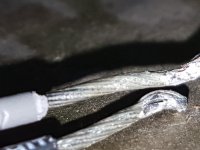
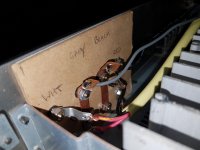
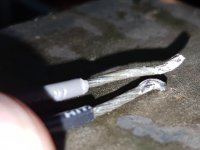
Finished Project - HK6100 rewired
As an aside from the original question of 'Why are steel wires inside my HK6100' I've now finished my project. I've repaired the speaker jacks by fabricating an new custom speaker jack from cannibalised parts and MDF. I re-cabled the original cable running from the speaker selector switch to the speaker jacks because I believed it was running too close to the transformer. I've also Deoxit'ed all the dials and volume control to remove the tarnish buildup that was causing static and some hum.
I'm not sure of the Deoxit or the Re-Routed speaker connector wires away from the transformer was responsible for eliminating the hum, but the hum is gone.
Photos attached:
As an aside from the original question of 'Why are steel wires inside my HK6100' I've now finished my project. I've repaired the speaker jacks by fabricating an new custom speaker jack from cannibalised parts and MDF. I re-cabled the original cable running from the speaker selector switch to the speaker jacks because I believed it was running too close to the transformer. I've also Deoxit'ed all the dials and volume control to remove the tarnish buildup that was causing static and some hum.
I'm not sure of the Deoxit or the Re-Routed speaker connector wires away from the transformer was responsible for eliminating the hum, but the hum is gone.
Photos attached:
That's good news, though you may find that using solvent/lubricant sprays is not a lasting fix for potentiometers. I've read and heard of a lot of short-term success stories but in the end, a worn carbon track is still a worn track and replacement with a reputable quality brand and grade of new pots is the best option for oft-used volume controls, at least.
The location of the speaker cables was certainly suspect since the speaker +ve leads are connected to the feedback circuit of the power amp and that could well result in injecting 50Hz + 100Hz hum to the input stage. That it was noticeable in only one channel makes this doubtful though. Had you moved the cable about and checked for variations by ear, you might have learned a bit more about this but it's moot now and at least you do have silence - enjoy!
The location of the speaker cables was certainly suspect since the speaker +ve leads are connected to the feedback circuit of the power amp and that could well result in injecting 50Hz + 100Hz hum to the input stage. That it was noticeable in only one channel makes this doubtful though. Had you moved the cable about and checked for variations by ear, you might have learned a bit more about this but it's moot now and at least you do have silence - enjoy!
- Status
- This old topic is closed. If you want to reopen this topic, contact a moderator using the "Report Post" button.
- Home
- Amplifiers
- Solid State
- Why is there Steel Wire in my Harman Kardon HK6100?